Is So-called Contextual Advertising the Cure to Surveillance-based “Behavioral” Advertising?

Contextual advertising is said to be privacy-safe because it eliminates the need for cookies, third-party trackers, and the processing of other personal data. Marketers and policy makers are placing much stock in the future of contextual advertising, viewing it as the solution to the privacy-invasive targeted advertising that heavily relies on personal data.
However, the current state of contextual advertising does not look anything like our plain understanding of it in contrast to today's dominant mode of behavioral advertising: placing ads next to preferred content, based on keyword inclusion or exclusion. Instead, industry practices are moving towards incorporating advanced AI analysis of content and its classification, user-level data, and insights into content preferences of online visitors, all while still referring to “contextual advertising.” It is crucial for policymakers to carefully examine this rapidly evolving space and establish a clear definition of what “contextual advertising” should entail. This will prevent the emergence of toxic practices and outcomes, similar to what we have witnessed with surveillance-based behavioral marketing, from becoming the new normal.
Let’s recall the reasons for the strong opposition to surveillance-based marketing practices so we can avoid those harms regarding contextual advertising. Simply put, the two main reasons are privacy harms and harms from manipulation. Behavioral advertising is deeply invasive when it comes to privacy, as it involves tracking users online and creating individual profiles based on their behavior over time and across different platforms and across channels. These practices go beyond individual privacy violations and also harm groups of people, perpetuating or even exacerbating historical discrimination and social inequities.
The second main reason why many oppose surveillance-based marketing practices is the manipulative nature of commercial messaging that aims to exploit users’ vulnerabilities. This becomes particularly concerning when vulnerable populations, like children, are targeted, as they may not have the ability to resist sophisticated influences on their decision-making. More generally, the behavioral advertising business heavily incentivizes companies to optimize their practices for monetizing attention and selling audiences to advertisers, leading to many associated harms.
New and evolving practices in contextual advertising should raise questions for policy makers. They should consider whether the harms we sought to avoid with behavioral marketing may resurface in these new advertising practices as well.
Today’s contextual advertising methods are taking advantage of the latest analytical technologies to interpret online content so that contextual ads will likely soon be able to manipulate us just as behavioral ads can. Artificial intelligence (AI), machine learning, natural language processing models for tone and sentiment analysis, computer vision, audio analysis, and more are being used to consider a multitude of factors and in this way “dramatically improve the effectiveness of contextual targeting.” Gumgum’s Verity, for example, “scans text, image, audio and video to derive human-like understandings.” Attention measures – the new performance metric that advertisers crave – indicate that contextual ads are more effective than non-contextual ads. Moments.AI, a “real-time contextual targeting solution” by the Verve Group, for example, allows brands to move away from clicks and to “optimize towards consumer attention instead,” for “privacy-first” advertising solutions.
Rather than analyzing one single URL or one article at a time, marketers can analyze a vast range of URLs and can “understand content clusters and topics that audiences are engaging with at that moment” and so use contextual targeting at scale. The effectiveness and sophistication of contextual advertising allows marketers to use it not just for enhancing brand awareness, but also for targeting prospects. In fact, the field of “neuroprogammatic” advertising “goes beyond topical content matching to target the subconscious feelings that lead consumers to make purchasing decisions,” according to one industry observer. Marketers can take advantage of how consumers “are feeling and thinking, and what actions they may or may not be in the mood to take, and therefore how likely are to respond to an ad. Neuroprogrammatic targeting uses AI to cater to precisely what makes us human.”
These sophisticated contextual targeting practices may have negative effects similar to those of behavioral advertising, however. For instance, contextual ads on weight loss programs can be placed alongside content related to dieting and eating disorders due to its semantic, emotional, and visual content. This may have disastrous consequences similar to targeted behavioral ads aimed at teenagers with eating disorders. Therefore, it is important to question how different these practices are from individual user tracking and ad targeting. If content can be analyzed and profiled along very finely tuned classification schemes, advertisers don’t need to track users across the web. They simply need to track the content that will deliver the relevant audience and engage individuals based on their interests and feelings.
Apart from the manipulative nature of contextual advertising, the use of personal data and associated privacy violations are also concerning. Many contextual ad tech companies claim to engage in contextual targeting “without any user data.” But, in fact, so-called contextual ad tech companies often rely on session data such as browser and page-level data, device and app-level data, IP address, and “whatever other info they can get their hands on to model the potential user,” framing it as “contextual 2.0.” Until recently, this practice might have been more accurately referred to as device fingerprinting. The claim is that session data is not about tracking, but only about the active session and usage at one point in time. No doubt, however, the line between contextual and behavioral advertising becomes blurry when such data is involved.
Location-based targeting is another aspect of contextual advertising that raises privacy concerns. Should location-based targeting be considered contextual? Uber’s “Journey Ads” lets advertisers target users based on their destination. A trip to a restaurant might trigger alcohol ads; a trip to the movie theater might result in ads for sugary beverages. According to AdExchanger, Uber claims that it is not “doing any individual user-based targeting” and suggests that it is a form of contextual advertising.
Peer 39 also includes location data in its ad-targeting capabilities and still refers to these practices as contextual advertising. The use of location data can reveal some of the most sensitive information about a person, including where she works, sleeps, socializes, worships, and seeks medical treatment. When combined with session data, the information obtained from sentiment, image, video, and location analysis can be used to create sophisticated inferences about individuals, and ads placed in this context can easily clash with consumer expectations of privacy.
Furthermore, placing contextual ads next to user-generated content or within chat groups changes the parameters of contextual targeting. Instead of targeting the content itself, the ad becomes easily associated with an individual user. Reddit’s “contextual keyword targeting” allows advertisers to target by community and interests, discussing LGBTQ+ sensitive topics, for example. This is similar to the personalized nature of targeted behavioral advertising, and can thus raise privacy concerns.
Cohort targeting, also referred to as “affinity targeting” or “content affinity targeting,” further blurs the line between behavioral and contextual advertising by combining content analytics with audience insights. “This bridges the gap between Custom Cohorts and your contextual signals, by taking learning from consented users to targeted content where a given Customer Cohort shows more engagement than the site average,” claims Permutive.
Oracle uses various cohorts with demographic characteristics, including age, gender, and income, for example, as well as “lifestyle” and “retail” interests, to understand what content individuals are more likely to consume. While reputedly “designed for privacy from the ground up,” this approach allows Oracle to analyze what an audience cohort views and to “build a profile of the content types they’re most likely to engage with,” allowing advertisers to find their “target customers wherever they are online.” Playground XYZ enhances contextual data with eye-tracking data from opt-in panels, which measures attention and helps to optimize which content is most “eye-catching,” “without the need for cookies or other identifiers.”
Although these practices may seem privacy neutral (relying on small samples of online users or “consented users”), they still allow advertisers to target and manipulate their desired audience. Message targeting based on content preferences of fine-tuned demographic characteristics (household income less than $20K or over $500K, for example) can lead to discriminatory practices and disparate impact that can deepen social inequities, just like the personalized targeting of online users.
Hyper-contextual content analysis with a focus on measuring sentiment and attention, the use of session information, placing ads next to user-generated content as well as within interest group chats, and employing audience panels to profile content are emerging practices in contextual advertising that require critical examination. The touted privacy-first promise of contextual advertising is deceptive. It seems that contextual advertising is more manipulative, invasive of privacy, and likely to contribute to discrimination and perpetuate inequities among consumers than we all initially thought.
What’s more, the convergence of highly sensitive content analytics with content profiling based on demographic characteristics (and potentially more), could result in even more potent digital marketing practices than those currently being deployed. By merging contextual data with behavioral data, marketers might gain a more comprehensive understanding of their target audience and develop more effective messaging. Additionally, we can only speculate about how modifications to the incentive structure for content delivery of audiences to advertisers might impact content quality.
In the absence of policy intervention, these developments may lead to a surveillance system that is even more formidable than the one we currently have. Contextual advertising will not serve as a solution to surveillance-based “behavioral” marketing and its manipulative and privacy invasive nature, let alone the numerous other negative consequences associated with it, including the addictive nature of social media, the promotion of disinformation, and threats to public health.
It is vital to formulate a comprehensive and up-to-date definition of contextual advertising that takes into consideration the adverse effects of surveillance advertising and strives to mitigate them. Industry self-regulation cannot be relied on, and legislative proposals do not adequately address the complexities of contextual advertising. The FTC’s 2009 definition of contextual advertising is also outdated in light of the advancements and practices described here. Regulatory bodies like the FTC must assess contemporary practices and provide guidelines to safeguard consumer privacy and ensure fair marketing practices. The FTC’s Children’s Online Privacy Protection Act rule update and its Commercial Surveillance and Data Security Rule provide opportunity to get it right.
Failure to intervene may ultimately result in the emergence of a surveillance system disguised as consumer-friendly marketing.
This article was originally published by Tech Policy Press.

